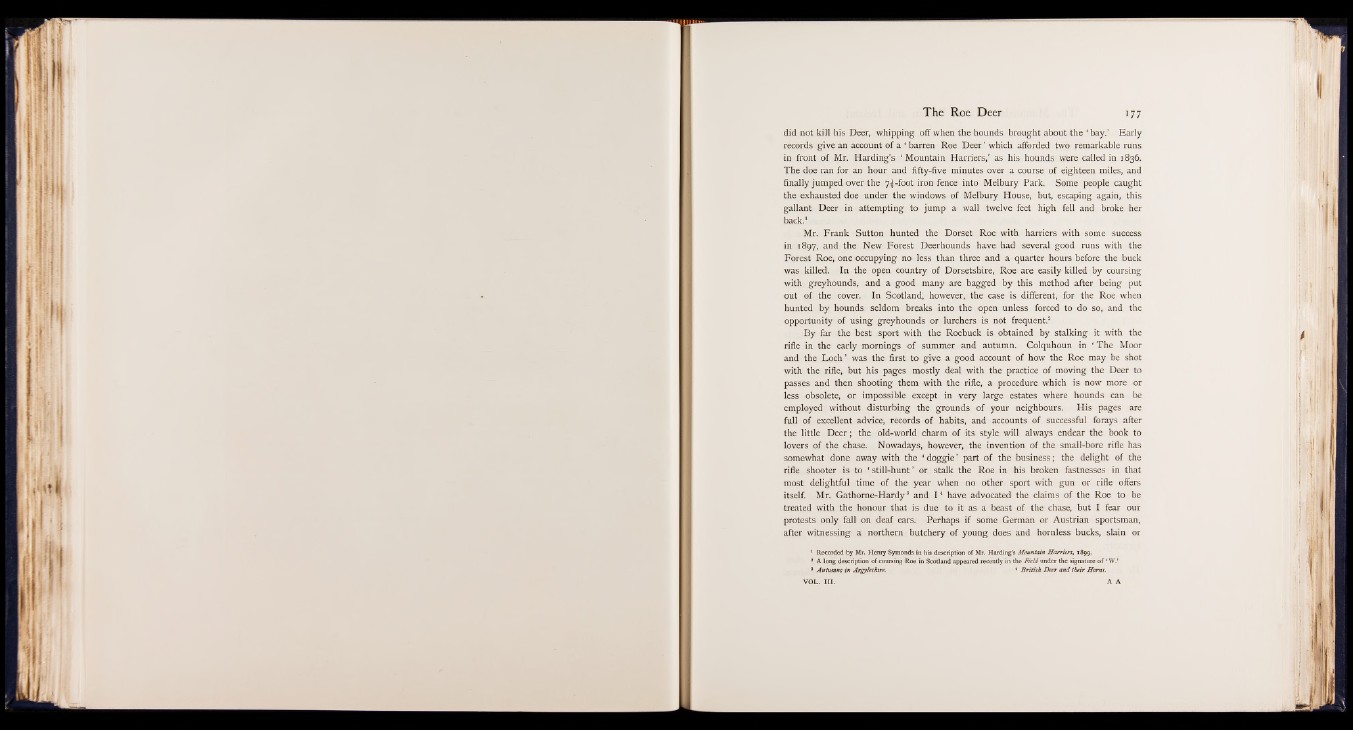
The Roe Deer
did not kill his Deer, whipping off when the hounds brought about the ' bay.’ Early
records give an account of a ‘ barren Roe Deer ’ which afforded two remarkable runs
in front of Mr. Harding’s ‘ Mountain Harriers,’ as his hounds were called in 1836.
The doe ran for an hour and fifty-five minutes over a course of eighteen miles, and
finally jumped over the 7^-foot iron fence into Melbury Park. Some people caught
the exhausted doe under the windows of Melbury House, but, escaping again, this
gallant Deer in attempting to jump a wall twelve feet high fell and broke her
back.1
Mr. Frank Sutton hunted the Dorset Roe with harriers with some success
in 1897, and the New Forest Deerhounds have had several good runs with the
Forest Roe, one occupying no less than three and a quarter hours before the buck
was killed. In the open country of Dorsetshire, Roe are easily killed by coursing
with greyhounds, and a good many are bagged by this method after being put
out of the cover. In Scotland, however, the case is different, for the Roe when
hunted by hounds seldom breaks into the open unless forced to do so, and the
opportunity of using greyhounds or lurchers is not frequent.1 2 *
By far the best sport with the Roebuck is obtained by stalking it with the
rifle in the early mornings of summer and autumn. Colquhoun in ‘ The Moor
and the Loch ’ was the first to give a good account of how the Roe may be shot
with the rifle, but his pages mostly deal with the practice of moving the Deer to
passes and then shooting them with the rifle, a procedure which is now more or
less obsolete, or impossible except in very large estates where hounds can be
employed without disturbing the grounds of your neighbours. His pages are
full of excellent advice, records of habits, and accounts of successful forays after
the little Deer; the old-world charm of its style will always endear the book to
lovers of the chase. Nowadays, however, the invention of the small-bore rifle has
somewhat done away with the ‘ doggie ’ part of the business; the delight of the
rifle shooter is to ‘ still-hunt ’ or stalk the Roe in his broken fastnesses in that
most delightful time of the year when no other sport with gun or rifle offers
itself. Mr. Gathorne-Hardy8 and I 4 have advocated the claims of the Roe to be
treated with the honour that is due to it as a beast of the chase, but I fear our
protests only fall on deaf ears. Perhaps if some German or Austrian sportsman,
after witnessing a northern butchery of young does and hornless bucks, slain or
1 Recorded by Mr. Henry Symonds in his description of Mr. Harding’s Mountain Harriers, 1899.
2 A long description o f coursing Roe in Scotland appeared recently in the Field under the signature o f ' W.’
* Autumns in Argyleshtre. * British Deer and their Homs.
VOL. III. A A